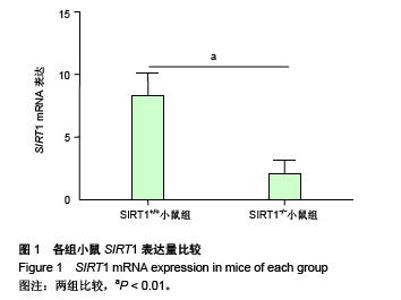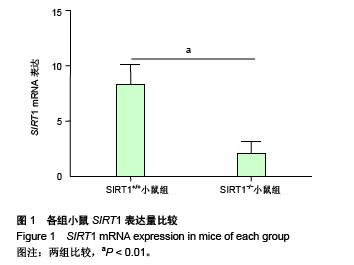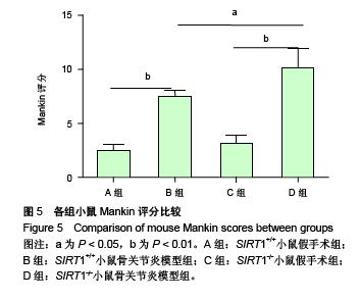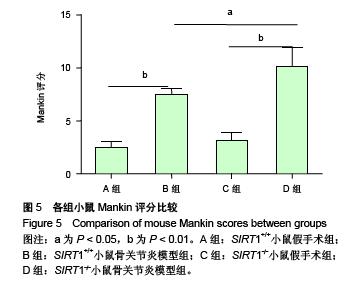Chinese Journal of Tissue Engineering Research ›› 2015, Vol. 19 ›› Issue (49): 7895-7901.doi: 10.3969/j.issn.2095-4344.2015.49.005
Previous Articles Next Articles
Construction of elderly SIRT1 gene knockout mouse models of knee osteoarthritis
Yu Fei, Lei Ming, Zeng Hui, Li Ming-hua, Xiao De-ming
- Peking University Shenzhen Hospital, Shenzhen 518036, Guangdong Province, China
-
Received:2015-09-05Online:2015-11-30Published:2015-11-30 -
Contact:Xiao De-ming, M.D., Chief physician, Peking University Shenzhen Hospital, Shenzhen 518036, Guangdong Province, China -
About author:Yu Fei, Studying for master’s degree, Peking University Shenzhen Hospital, Shenzhen 518036, Guangdong Province, China -
Supported by:the National Natural Science Foundation of China, No. 81272032; a grant from Health and Family Planning Committee of Shenzhen of China, No. 201302064; a grant from Science and Technology Innovation Committee of Shenzhen of China, No. JCY20130402114702130
CLC Number:
Cite this article
Yu Fei, Lei Ming, Zeng Hui, Li Ming-hua, Xiao De-ming. Construction of elderly SIRT1 gene knockout mouse models of knee osteoarthritis[J]. Chinese Journal of Tissue Engineering Research, 2015, 19(49): 7895-7901.
share this article
| [1] Zhang W,Nuki G,Moskowitz RW,et al.OARSI recommendations for the management of hip and knee osteoarthritis:part Ⅲ: changes in evidence following systematic cumulativeupdate of research published through January 2009.Osteoarthritis Cartilage. 2010;18(4):476-499. [2] Milner J.Cellular regulation of SIRT1.Curr Pharm Des. 2009; 15(1):39-44. [3] Lafont JE.Lack of oxygen in articular cartilage:consequences for chondrocyte biology. Int J Exp Pathol. 2010;91(2):99-106. [4] Fujita N,Matsushita T,Ishida K,et al.Potential involvement of SIRT1 in the pathogenesis of osteoarthritis through the modulation of chondrocyte gene expressions. J Orthop Res. 2011;29(4):511-515. [5] Takayama K,Ishida K,Matsushita T,et al.SIRT1 regulation of apoptosis of human chondrocytes. Arthritis Rheum. 2009; 60(9):2731-2740. [6] Yuan Z,Zhang X,Sengupta N,et al.SIRT1 regulates the function of the Nijmegen breakage syndrome protein. Mol Cell. 2007,27(1):149-162. [7] Liao S,Guay C,Toczylowski T,et al.Analysis of MRE11's function in the 5'-->3' processing of DNA double-strand breaks. Nucleic Acids Res. 2012;40(10):4496-4506. [8] Lee SY,Lee H,Kim ES,et al.WRN translocation from nucleolus to nucleoplasm is regulated by SIRT1 and required for DNA repair and the development of chemoresistance. Mutat Res. 2015;774:40-48. [9] Mongkhon JM, Thach M, Shi Q,et al.Sorbitol-modified hyaluronic acid reduces oxidative stress, apoptosis and mediators of inflammation and catabolism in human osteoarthritic chondrocytes. Inflamm Res. 2014;63(8): 691-701. [10] Tran D,Bergholz J,Zhang H,et al.Insulin-like growth factor-1 regulates the SIRT1-p53 pathway in cellular senescence. Aging Cell. 2014;13(4):669-678. [11] Cohen HY,Miller C,Bitterman KJ,et al.Calorie restriction promotes mammalian cell survival by inducing the SIRT1 deacetylase.Science. 2004; 305(5682):390-392. [12] van der Kraan PM,van den Berg WB.Osteoarthritis in the context of ageing and evolution. Loss of chondrocyte differentiation block during ageing. Ageing Res Rev. 2008; 7(2):106-113. [13] Rodgers JT,Lerin C,Cerhart-Hines Z,et al.Metabolic adaptations through the PGC-1 alpha and SIRTI pathways. FEBS Lett. 2008;582(1):46-53. [14] Ren T, Huang C, Cheng M. Dietary blueberry and bifidobacteria attenuate nonalcoholic fatty liver disease in rats by affecting SIRT1-mediated signaling pathway. Oxid Med Cell Longev. 2014;2014:469059. [15] Laiguillon MC,Courties A,Houard X,et al.Characterization of diabetic osteoarthritic cartilage and role of high glucose environment on chondrocyte activation: toward pathophysiological delineation of diabetes mellitus-related osteoarthritis. Osteoarthritis Cartilage. 2015; pii: S1063-4584 (15)01147-4. [16] Kostopoulou F,Gkretsi V,Malizos KN,et al.Central role of SREBP-2 in the pathogenesis of osteoarthritis. PLoS One. 2012;7(5):e35753. [17] Li H,Rajendran GK,Liu N, et al.SIRT1 modulates the estrogen- insulin-like growth factor-1 signaling for postnatal development of mammary glandin mice.Breast Cancer Res. 2007;9(1):R1. [18] Nakamura E,Nguyen MT,Mackem S.Kinetics of tamoxifen- regulated Cre activity in mice using a cartilage-specific CreER(T) to assay temporal activity windows along the proximodistal limb skeleton. Dev Dyn. 2006;235(9): 2603-2612. [19] Wang J,Dong FF,Li XF,et al.Effects of Yiqi Huayu prescription on knee cartilage degeneration in HIF-1 gene knockout Mice. China J Orthop Trauma. 2013;26(6):486-492. [20] Maximum Lifespan As a Biomarker of Aging-The Jackson Laboratory.http://research.jax.org/faculty/harrison/gerlvLifespan1.html. [21] Zhang W,Nuki G,Moskowitz RW,et al.OARSI recommendations for the management of hip and knee osteoarthritis:part Ⅲ: changes in evidence following systematic cumulativeupdate of research published through January 2009. Osteoartliritis Cartilage. 2010;18(4):476-499. [22] Lawrence RC,Felson DT,Helmick CQ, et al.Estimates of the prevalence of arthritis and other rheumatic conditions in the United States.Part II. Arthritis Rheum. 2008;58(1):26-35. [23] Helmick CG,Felson DT,Lawrence RC, et al.Estimates of the prevalence of arthritis and other rheumatic conditions in the United States. Part I. Arthritis Rheum. 2008;58(1):15-25. [24] de Oliveira RM,Pais TF,Outeiro TF.SIRTuins:common targets in aging and in neurodegeneration.Curr Drug Targets. 2010; 11(10):1270-1280. [25] Lei M,Wang JG,Xiao DM,et al.Resveratrol inhibits interleukin 1β-mediated inducible nitric oxide synthase expression in articular chondrocytes by activating SIRT1 and thereby suppressing nuclear factor-κB activity. Eur J Pharmacol.2012; 674(2-3):73-79. [26] Huh YH,Ryu JH,Chun JS.Regulation of type II collagen expression by histone deacetylase in articular chondrocytes. J Biol Chem. 2007;282(23):17123-17131. [27] Liu FC,Hung LF,Wu WL,et al.Chondroprotective effects and mechanisms of resveratrol in advanced glycation end products- stimulated chondrocytes. Arthritis Res Ther. 2010; 12(5):R167. [28] Hong EH,Lee SJ,Kim JS,et al.Ionizing radiation induces cellular senescence of articular chondrocytes via negative regulation of SIRT1 by p38 kinase. J Biol Chem. 2010;285(2): 1283-1295. [29] Lei M,Liu SQ,Liu YL.Resveratrol protects bone marrow mesenchymal stem cell derived chondrocytes cultured on chitosan-gelatin scaffolds from the inhibitory effect of interleukin- 1beta.Acta Pharmacol Sin. 2008;29(11): 1350-1356. [30] Elmali N,Esenkaya I,Harma A,et al.Effect of resveratrol in experimental osteoarthritis in rabbits. Inflamm Res. 2005; 54(4): 158-162. [31] Lozoya KA, Flores JB. A novel rat osteoarthrosis model to assess apoptosis and matrix degradation. Pathol Res Pract. 2000;196:729-745. [32] Mostkowitz RW,Davis W,Sammarco J,et al.Experimentally induced degenerative joints lesion following partial menisectomy in the rabbit. Arthritis Rheum. 1973;16:397-405. [33] Stoop R,Buma P,van der Kraan M,et al.Type Ⅱ collagen degradation in articular cartilage fibrillation after anterior cruciate ligament transection in rats. Osteoarthritis Cartilage. 2001;9:308-315. [34] Guingamp C,Gegout-Pottie P,Philippe L.Mono-iodoacetate- induced experimental osteoarthrit is:a dose-response study of loss of mobility,morphology,and biochemistry. Arthritis Rheum. 1997;40:1670-1679. [35] Saied A,Cherin E,Gaucher H,et al.Assessment of art icular cart ilage and subchondral bone:subtle and progressive changes in experimental osteoarthritis using 50 MHz echography in vitro.J Bone Miner Res. 1997;12:1378-1386. [36] Palmoski MJ,Colyer RA,Brandt KD,et al.Joint mot ion in the absence of normal loading does not maintain normal arti cular cartilage. Arthritis Rheum. 1980;23:325-334. [37] Gu Y,Dai KR,Qiu SJ,et al.A Morphological Stydy of Degenerative Mechanism of Articular Cartiage Induced by Low Stress.Chin J Orthop. 1995;15:631-633. [38] Masanori H.Changes in the nucleus pulposus of the intervertebral disc in bipedal mice. Clin Orthop.1983;175: 251-262. [39] Machner A,Pap G,Schwarzberg H,et al.Deterioration of sensory joint innervation as an enabling factor for development of arthrosis.An animal experiment study of the rat model. Z Rheumatol. 1999;58:148-154. [40] de Bri E,Jonsson K,Reinholt FP,et al.Focal destruction and remodeling in guinea pig arthrosis.Acta Orthop Scand. 1996; 67: 498-504. [41] Bendele AM,Hulman JF.Spontaneous carti lage degeneration in guinea pigs. Arthritis Rheum. 1988;31:561-565. |
| [1] | Chen Ziyang, Pu Rui, Deng Shuang, Yuan Lingyan. Regulatory effect of exosomes on exercise-mediated insulin resistance diseases [J]. Chinese Journal of Tissue Engineering Research, 2021, 25(25): 4089-4094. |
| [2] | Chen Yang, Huang Denggao, Gao Yuanhui, Wang Shunlan, Cao Hui, Zheng Linlin, He Haowei, Luo Siqin, Xiao Jingchuan, Zhang Yingai, Zhang Shufang. Low-intensity pulsed ultrasound promotes the proliferation and adhesion of human adipose-derived mesenchymal stem cells [J]. Chinese Journal of Tissue Engineering Research, 2021, 25(25): 3949-3955. |
| [3] | Yang Junhui, Luo Jinli, Yuan Xiaoping. Effects of human growth hormone on proliferation and osteogenic differentiation of human periodontal ligament stem cells [J]. Chinese Journal of Tissue Engineering Research, 2021, 25(25): 3956-3961. |
| [4] | Sun Jianwei, Yang Xinming, Zhang Ying. Effect of montelukast combined with bone marrow mesenchymal stem cell transplantation on spinal cord injury in rat models [J]. Chinese Journal of Tissue Engineering Research, 2021, 25(25): 3962-3969. |
| [5] | Gao Shan, Huang Dongjing, Hong Haiman, Jia Jingqiao, Meng Fei. Comparison on the curative effect of human placenta-derived mesenchymal stem cells and induced islet-like cells in gestational diabetes mellitus rats [J]. Chinese Journal of Tissue Engineering Research, 2021, 25(25): 3981-3987. |
| [6] | Hao Xiaona, Zhang Yingjie, Li Yuyun, Xu Tao. Bone marrow mesenchymal stem cells overexpressing prolyl oligopeptidase on the repair of liver fibrosis in rat models [J]. Chinese Journal of Tissue Engineering Research, 2021, 25(25): 3988-3993. |
| [7] | Liu Jianyou, Jia Zhongwei, Niu Jiawei, Cao Xinjie, Zhang Dong, Wei Jie. A new method for measuring the anteversion angle of the femoral neck by constructing the three-dimensional digital model of the femur [J]. Chinese Journal of Tissue Engineering Research, 2021, 25(24): 3779-3783. |
| [8] | Meng Lingjie, Qian Hui, Sheng Xiaolei, Lu Jianfeng, Huang Jianping, Qi Liangang, Liu Zongbao. Application of three-dimensional printing technology combined with bone cement in minimally invasive treatment of the collapsed Sanders III type of calcaneal fractures [J]. Chinese Journal of Tissue Engineering Research, 2021, 25(24): 3784-3789. |
| [9] | Qian Xuankun, Huang Hefei, Wu Chengcong, Liu Keting, Ou Hua, Zhang Jinpeng, Ren Jing, Wan Jianshan. Computer-assisted navigation combined with minimally invasive transforaminal lumbar interbody fusion for lumbar spondylolisthesis [J]. Chinese Journal of Tissue Engineering Research, 2021, 25(24): 3790-3795. |
| [10] | Hu Jing, Xiang Yang, Ye Chuan, Han Ziji. Three-dimensional printing assisted screw placement and freehand pedicle screw fixation in the treatment of thoracolumbar fractures: 1-year follow-up [J]. Chinese Journal of Tissue Engineering Research, 2021, 25(24): 3804-3809. |
| [11] | Shu Qihang, Liao Yijia, Xue Jingbo, Yan Yiguo, Wang Cheng. Three-dimensional finite element analysis of a new three-dimensional printed porous fusion cage for cervical vertebra [J]. Chinese Journal of Tissue Engineering Research, 2021, 25(24): 3810-3815. |
| [12] | Wang Yihan, Li Yang, Zhang Ling, Zhang Rui, Xu Ruida, Han Xiaofeng, Cheng Guangqi, Wang Weil. Application of three-dimensional visualization technology for digital orthopedics in the reduction and fixation of intertrochanteric fracture [J]. Chinese Journal of Tissue Engineering Research, 2021, 25(24): 3816-3820. |
| [13] | Sun Maji, Wang Qiuan, Zhang Xingchen, Guo Chong, Yuan Feng, Guo Kaijin. Development and biomechanical analysis of a new anterior cervical pedicle screw fixation system [J]. Chinese Journal of Tissue Engineering Research, 2021, 25(24): 3821-3825. |
| [14] | Lin Wang, Wang Yingying, Guo Weizhong, Yuan Cuihua, Xu Shenggui, Zhang Shenshen, Lin Chengshou. Adopting expanded lateral approach to enhance the mechanical stability and knee function for treating posterolateral column fracture of tibial plateau [J]. Chinese Journal of Tissue Engineering Research, 2021, 25(24): 3826-3827. |
| [15] | Zhu Yun, Chen Yu, Qiu Hao, Liu Dun, Jin Guorong, Chen Shimou, Weng Zheng. Finite element analysis for treatment of osteoporotic femoral fracture with far cortical locking screw [J]. Chinese Journal of Tissue Engineering Research, 2021, 25(24): 3832-3837. |
| Viewed | ||||||
|
Full text |
|
|||||
|
Abstract |
|
|||||







